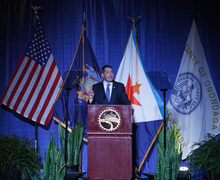Setnor Ensemble Series hosts wind, orchestra groups for autumnal performance
Lars Jendruschewitz | Photo Editor
Syracuse University Symphony Orchestra and Wind Ensemble perform in Setnor Auditorium as part of the Setnor Ensemble Series. The Wind Ensemble performed many compositions by Latine composers for Latine Heritage Month.
Get the latest Syracuse news delivered right to your inbox.
Subscribe to our newsletter here.
As Syracuse University student musicians walked out on stage dressed in all black, the loud chatters of the audience turned silent and the bass bellowed.
Freshmen Katelynn Thomas, Danessa Olivo and Khloe ElDorrado sat eagerly in the front row, supporting their friend who plays the cello. Although this was their first time listening to orchestral music, they connected with the emotion of each piece.
“I kept saying that it was very cinematic, almost like you were in a chase scene,” Olivo said. “I think each piece felt powerful in a fairy-like sense. It felt like something only music could accomplish.”
The Setnor Ensemble Series hosted the Syracuse University Symphony Orchestra and the Wind Ensemble Tuesday night in Setnor Auditorium. This is the first time the two groups have shared the stage since before the COVID-19 pandemic.
In total, the groups performed eight pieces, ranging from three to 26 minutes in length.
The night featured two different soloists — Michael Hernandez, an SU alum and saxophonist, and Scott Cuellar, a pianist and an assistant professor of applied music and performance at SU. Hernandez joined the wind ensemble and played music by Latine composers in honor of Latine Heritage Month. The group also performed Hernandez’s saxophone concerto.
The Wind Ensemble, a concert band with wind, woodwinds, brass and percussion instruments, played a variety of pieces from the 16th century to present day. The ensemble performed “Fanfare to La Péri,” “La Celebración” and Sahuaro from “Little Mexican Suite,” as well as the world premiere of “Eyes to Look Otherwise.”
“I love being in front of people and making music,” said Dr. Bradley Ethington, SU’s director of bands and conductor of the Wind Ensemble. “I was very passionate about that. Simple enough.”
A short intermission followed before SUSO took the stage with renditions of“Piano Concerto No. 2 in G minor, Op. 22,” featuring Cuellar, and finishing with “Sorcerer’s Apprentice.”
Honoring the fall season, SUSO and the Wind Ensemble chose autumnal pieces, which were intense in both feeling and artistry, SUSO’s conductor, Dr. James Tapia, said. The orchestra’s main piece, “Sorcerer’s Apprentice,” follows the story of a young apprentice who enchants a broom and a bucket that fills a castle with water.
“The first movement is very melodramatic and intricate. The second movement is filled with jocularity. The third movement is an aggressive boiling kind of piece,” Tapia said.
Tapia said creating a tumultuous experience for the audience challenges him intellectually, emotionally and musically. Conducting requires a level of understanding of how to create impact for the audience.
“It is a very diverse repertoire that is being presented, music from the 1800s all the way up to the music of today,” Tapia said. “To have that kind of repertoire of diversity is really spectacular, and not something that is always available.”
Cuellar, who performed with SUSO, has been praised for his fluidity on the keyboard and for bringing forth heavy emotions. Cuellar said he takes time to remind himself how lucky he is to be playing the piano as a professional.
“There’s a catharsis that can happen on stage if everything goes right, which is sort of an indescribable feeling…akin to riding a wave,” Cuellar said.
Gabriel Howe, a cellist in the performance, started playing when he was in second grade.
Howe said music, when he is “doing his thing,” becomes an escape. Since this is the first time SUSO and the Wind Ensemble have performed together since COVID, he welcomed the collaboration.
“We’re an extended family at this point, we all know who each other are,” Howe said. “It becomes a very unifying undertaking because otherwise it’s just not going to work. We connect with each other and become one.”
The music took the audience on a journey as it intensified throughout the performance. Both ensembles had students who crossed over between wind and orchestra portions.
“Different music evokes different emotions. But that’s why we make music, because each piece of music, each type of music, is historical and emotional in content. And that’s the magic of music, every piece is different,” Ethington said.
Published on October 9, 2024 at 1:18 am






